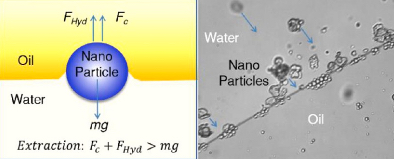Shaking out the nanomaterials: a new method to purify water
December 10, 2015

Extracting one- and two-dimensional nanomaterials from contaminated water (credit: Michigan Tech)
A new study published in the American Chemical Society’s journal Applied Materials and Interfaces has found a novel—and very simple—way to remove nearly 100 percent of nanomaterials from water.
Water and oil don’t mix, of course, but shaking them together is what makes salad dressing so great. Only instead of emulsifying and capturing bits of shitake or basil in tiny olive oil bubbles, this mixture grabs nanomaterials.
Dongyan Zhang, a research professor of physics at Michigan Tech, led the experiments, which covered tests on carbon nanotubes, graphene, boron nitride nanotubes, boron nitride nanosheets and zinc oxide nanowires. Those are used in everything from carbon fiber golf clubs to sunscreen.
“These materials are very, very tiny, and that means if you try to remove them and clean them out of contaminated water, that it’s quite difficult,” Zhang says, adding that techniques like filter paper or meshes often don’t work.
What makes shaking work is the shape of one- and two-dimensional nanomaterials. As the oil and water separate after some rigorous shaking, the wires, tubes and sheets settle at the bottom of the oil, just above the water. The oils trap them. However, zero-dimensional nanomaterials, such as nanospheres do not get trapped.
Green Nanotechnology
We don’t have to wait until the final vote is in on whether nanomaterials have a positive or negative impact on people’s health and environmental health. With the simplicity of this technique, and how prolific nanomaterials are becoming, removing nanomaterials makes sense. Also, finding ways to effectively remove nanomaterials sooner rather than later could improve the technology’s market potential.
“Ideally for a new technology to be successfully implemented, it needs to be shown that the technology does not cause adverse effects to the environment,” the authors write. “Therefore, unless the potential risks of introducing nanomaterials into the environment are properly addressed, it will hinder the industrialization of products incorporating nanotechnology.”
Purifying water and greening nanotechnology could be as simple as shaking a vial of water and oil.
Michigan Technological University | Shaking the Nanomaterials Out: New Method to Purify Water
Abstract of A Simple and Universal Technique To Extract One- and Two-Dimensional Nanomaterials from Contaminated Water
We demonstrate a universal approach to extract one- and two-dimensional nanomaterials from contaminated water, which is based on a microscopic oil–water interface trapping mechanism. Results indicate that carbon nanotubes, graphene, boron nitride nanotubes, boron nitride nanosheets, and zinc oxide nanowires can be successfully extracted from contaminated water at a successful rate of nearly 100%. The effects of surfactants, particle shape, and type of organic extraction fluids are evaluated. The proposed extraction mechanism is also supported by in situ monitoring of the extraction process. We believe that this extraction approach will prove important for the purification of water contaminated by nanoparticles and will support the widespread adoption of nanomaterial applications.